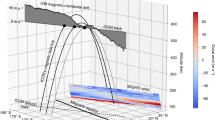Abstract
FOR a plane Earth and horizontally stratified ionosphere, Breit and Tuve's theorem1 gives the relation between the effective oblique path-length P′ travelled by a radio-wave packet and the corresponding ground-range D as: P′ = D sec Δ where Δ is the angle of elevation of the ray path relative to the ground. Provided that the electron density within the layer is a function of height only and that there is no imposed magnetic field, this relation is rigorously true for any density–height profile.
This is a preview of subscription content, access via your institution
Access options
Subscribe to this journal
Receive 51 print issues and online access
$199.00 per year
only $3.90 per issue
Buy this article
- Purchase on Springer Link
- Instant access to full article PDF
Prices may be subject to local taxes which are calculated during checkout
Similar content being viewed by others
References
Breit, G., and Tuve, M. A., Phys. Rev., 28, 554 (1926).
Appleton, E. V., and Beynon, W. J. G., D.S.I.R. Rad. Res. Spec. Rep. No. 18 (1948).
Shearman, E. D. R., Proc. Inst. Elec. Eng., 103, B, 210 (1956).
Forsterling, K., and Lassen, H., Z. tech. Phys., 12, 502 (1931).
McCue, C. G., Austral. J. Phys., 9, 454 (1956).
Author information
Authors and Affiliations
Rights and permissions
About this article
Cite this article
GETHING, P. Relation between Oblique and Ground Path-lengths in Ionospheric Propagation over a Curved Earth. Nature 193, 260–261 (1962). https://doi.org/10.1038/193260a0
Issue Date:
DOI: https://doi.org/10.1038/193260a0
Comments
By submitting a comment you agree to abide by our Terms and Community Guidelines. If you find something abusive or that does not comply with our terms or guidelines please flag it as inappropriate.



